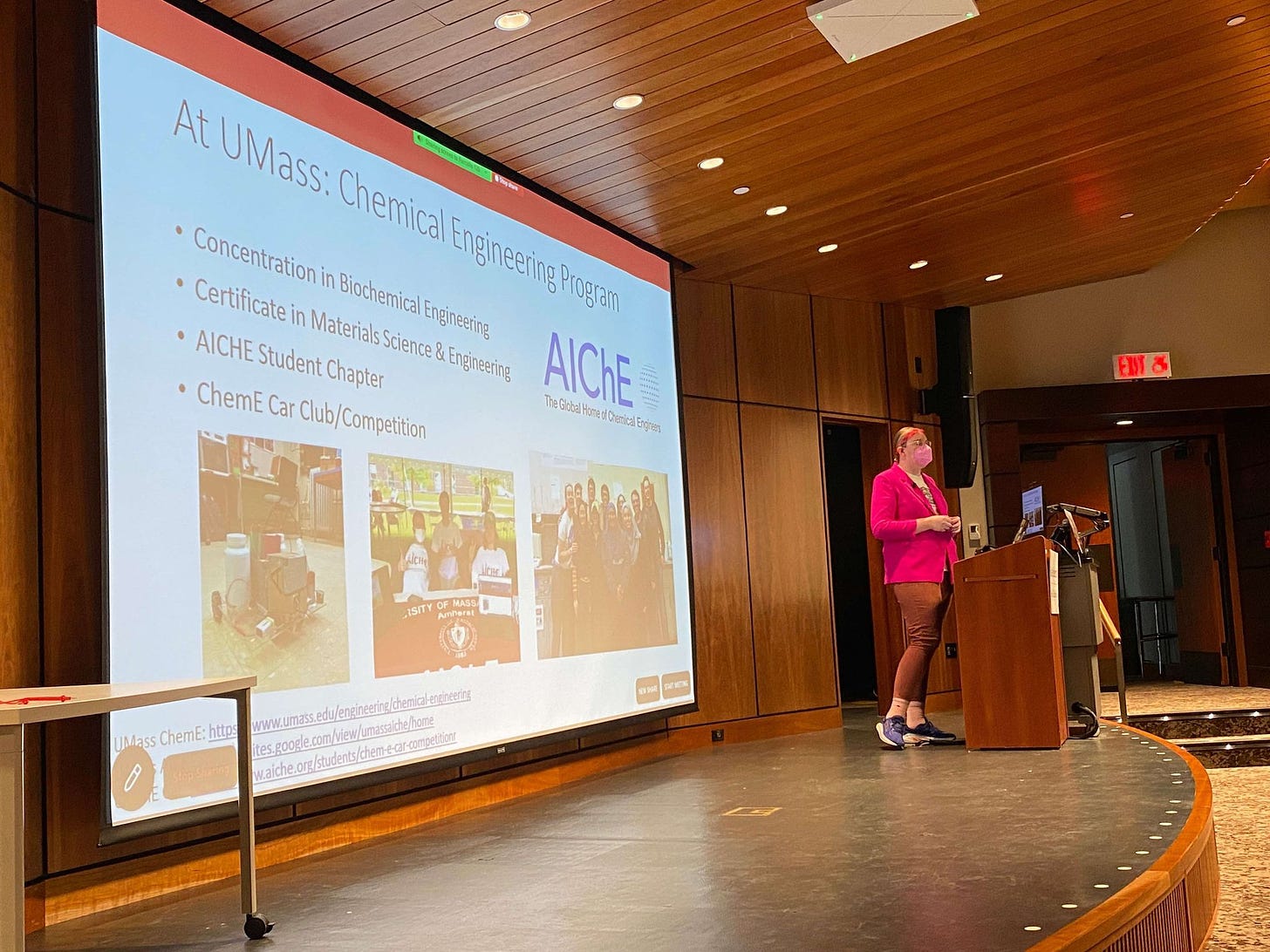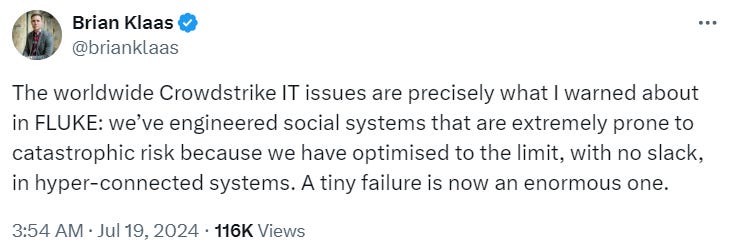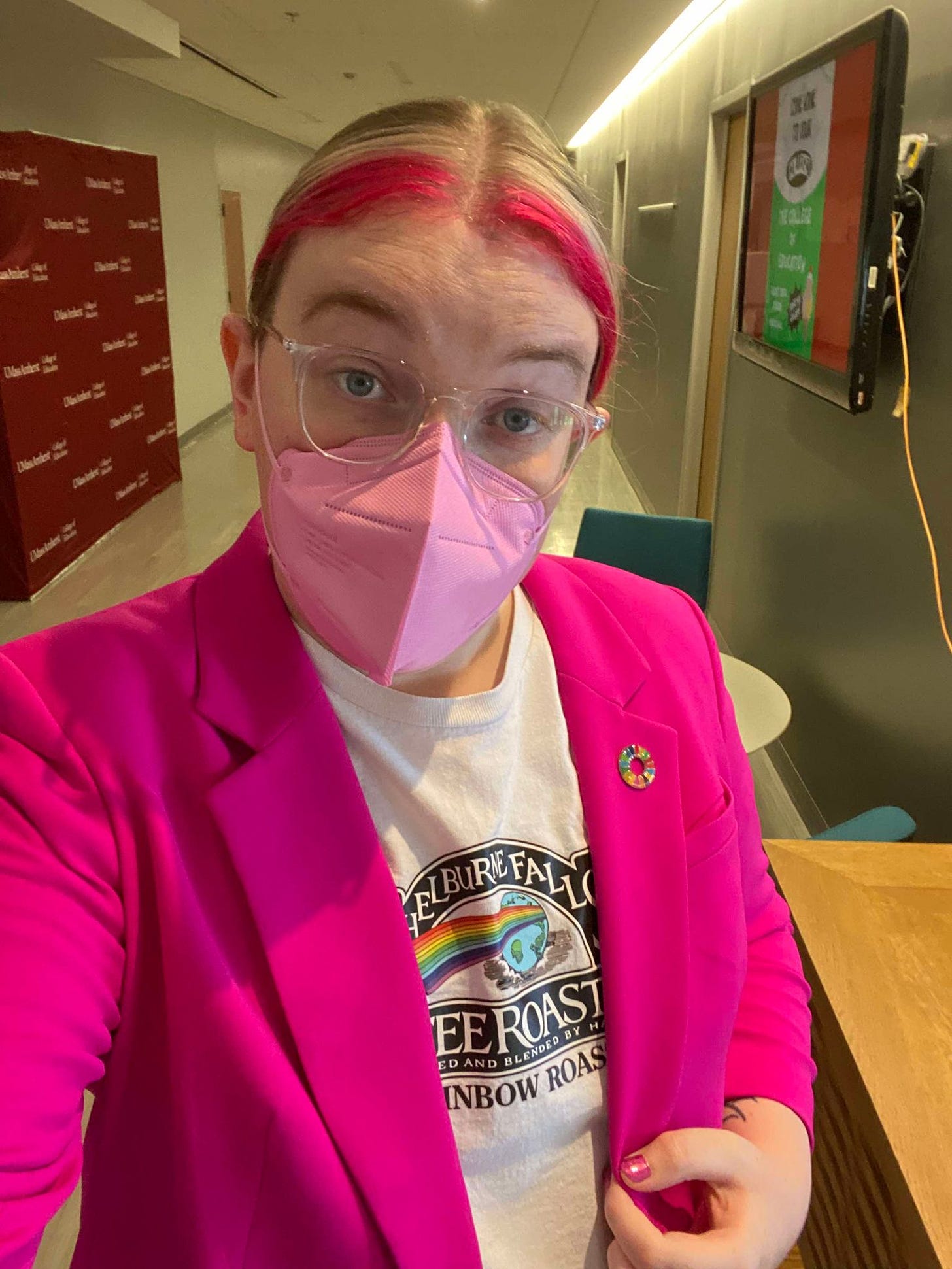What The CrowdStrike Crash Shows Us About Worker Power
On climate hope, IT failures, and taking on the ruling class.
Real quick up top: I’m now giving all my Substack income to help Ghazal and her family flee Gaza. In June 2024, we raised $91.72! Thank you so much to my paid subscribers! If you want to help too, consider upgrading to the paid tier; if you do, you’ll get four hot takes per month instead of two!
This Friday, I was giving a talk to a group of high school students for an engineering summer school program at UMass Amherst. I was tasked with teaching them about sustainable chemical engineering, as is my brand! Naturally, along with the standard description of “what you can do with a chemical engineering degree” (answer: whatever you want!), I casually dropped some of my hotter takes on environmentalism. I talked about everything from corporate greenwashing, to the farce of plastic recycling, to the limitations of life cycle assessments.

At the end of my presentation, a student had a question about the future of sustainable energy. A part of my talk was about the dangers of fossil fuels and the promise of renewables, so they asked me about “what version of renewable energy is the best” for replacing fossil fuels. This is a completely normal question to ask, but here’s essentially what I told the student…
The key to sustainability is diversifying our energy sources. The fossil fuel industry loves to tell us that “solar can’t replace all of our energy consumption because of clouds” or “wind can’t replace all of our energy consumption because of storage challenges”, etc etc, which is why “we need fossil fuels, their reliability and energy density is just too good”. It is true that fossil fuels have their benefits and that there is no one technological silver bullet to stop climate change: solar alone, wind alone, etc. will not be enough to single-handedly replace all fossil fuel use in all cases. However, no one energy source has to carry that burden because we have hydrogen and solar and wind and hydroelectric and more.
Envision this possible future: instead of people in all over the U.S. depending on one energy source that processed by a few plants in Texas and New Mexico and then shipped across the country via leaky pipeline, all people would have access to a wide diversity of energy options that are local to where they actually live. Nearly everyone would have access to solar, wind, geothermal energy, etc., but in addition to this, every location has their own unique energy portfolio: those who live by coasts are slightly more reliant on offshore wind and wave power, while those who live inland are slightly more reliant on solar and biofuel from crops. I’ve made the same argument about bioplastics in the past: instead of all our packaging coming from a few centralized production plants, those who live by the coasts can wrap their food in seaweed-based bioplastics, while those who live by farms can use corn-based PLA.
This future—one where we’re reliant on what our local ecosystem can provide for us—should be incredibly easy for us to imagine. However, capitalists have limited our collective imagination. We currently live in a monopoly economy where our food, energy, and other daily needs are provided to us by a shrinking number of companies. As a result, we are not only dependent on these companies for survival, but we’re so alienated from food production that we’re clueless as to alternative futures. Fossil fuels did not dominate the world simply because they are the best form of energy in the world from a technological standpoint; they dominated because it was the form of energy that was easiest to control via monopolization. As Kevin Young argues in his new book “Abolishing Fossil Fuels: Lessons from Movements That Won”…
The world’s current addiction to fossil fuels was never predestined by superior efficiency or human nature. Rather, the global adoption of coal, oil, and gas was the outcome of power struggles between elites and masses and among competing elites, in which the victors succeeded in forcing others to pay the costs of their actions. Fossil fuels were chosen because they enhanced the power and profits of key elite sectors. The beneficiaries were not limited to those who controlled the resources themselves, which were unevenly distributed and thus more easily monopolized than sunlight, wind, or water. Other capitalists realized that fossil fuels could enhance their control within their enterprises and in society broadly. State elites, particularly in Britain and the United states, also came to see fossil fuels as conferring geopolitical advantages over their global rivals. The physical nature of fossil fuels—the sheer density of potential energy they contained—facilitated that process, but it was not the main reason why they came to dominate. (pg. 34)
Young goes on to draw parallels between other forms of labor control through automation—e.g., many skilled textile workers being replaced by one “unskilled” worker using a steam-powered loom—and the replacement of skilled coal and rail workers being replaced with oil, which can operate using largely automated production plants and pipelines. Fossil fuels emerged, in part, as a form of labor control. When the whole world is dependent on one kind of energy (fossil fuels), that is much easier to control than a world dependent on a wide variety of energy sources.
This capture of our imagination was not accidental, either. Whenever there’s a rise in gas prices, or some other oil-related crisis such as a global conflict or an energy snap, the narrative is never “wow, looks like our reliance on fossil fuels is a national security threat” or “hey, maybe should diversify our energy sources so that Americans don’t have to pay more for gas whenever two countries go to war”. Instead, these watershed moments are used as a justification for even fewer regulations and even more money for fossil fuel companies (so they can “be more responsive to sudden crises”), thus centralizing their power even more. These companies can afford great PR, plus politicians who will back them up no matter what.
Divesting from fossil fuels will not be easy—years of dependence and monopolization has created a “carbon lock-in” effect where dominant economic forces are less incentivized to abandon their old investments—and yet it must be done to save the world. The challenge is not only technological, but political: how do we force our government to mobilize our economy toward renewables? This is the crux of Young’s book, and it’s a challenge I posed to the high school students as well (“get out there and get involved in some climate action orgs!”)
I can’t deny that this is an intimidating problem—changing the entire world—but a few events from the past few years have given me lots of hope. I’m reminded of the Ever Given ship in the Suez Canal, how one sideways boat halted huge segments of the global economy. Imagine how a few incidents like this would bring the economy (thus the ruling class) to their knees? We like to think of capitalism as a Lovecraftian evil, an ever-present malevolent force that can never truly be defeated, only coped with. That’s not accurate at all; laborers have far more power than we know to disrupt the status quo and get what we want, as I’ve made a podcast about in the past.
Speaking of global shutdowns, another thing happened on Friday that proves this point. In case you missed it, more than a billion Windows computers were shut down thanks to a bad software update being pushed out by cybersecurity company CrowdStrike. I’ll direct you elsewhere for a full explanation of what happened, but essentially it’s this: Most businesses are reliant on professional cybersecurity companies like CrowdStrike to protect their businesses from cyberattacks. These companies regularly push updates to their clients’ computers so they can be protected against the latest threats (viruses, hackers, etc.) It just so happened that July 19th update had a coding error that caused a major crash to computers around the world.
Crowdstrike is one of the leading brands for cybersecurity software, controlling ~18.5% of the cybersecurity market. In other words, roughly one in five computers that uses advanced cybersecurity runs their software. So when this buggy update got pushed out, it caused the Windows computers in businesses around the world to get the dreaded Blue Screen of Death (BSoD). This led to some hilarious memes, but more importantly, it led to some pretty alarming shutdowns. Major airlines, banks, and emergency services were down for hours before a new update could be pushed out and repaired. One take from “FLUKE” author Brian Klaas is prescient here…

Our global infrastructure is far more vulnerable than we think it is. Most of IT is held together with duct tape and prayers. This is both a good and a bad thing: on one hand, we’re currently very reliant on these systems for food, transportation, energy and more, so any shutdowns can cause disruptive chaos. On the other, if the working class can wield this vulnerability to our advantage, we can get whatever we want.
This is not a call for eco-cyberterrorism. (I think…) It’s just worth noting that airlines—which contribute 2.5% of all CO2 emissions—were shut down incredibly easily by a tiny software slip-up. And it’s worth noting that at time of this writing—48 hours after the massive system shutdown—40% of Israel’s major organizations are still affected. I’m left wondering, what would it take for a few dedicated protestors to stop the genocidal bombing of Gaza altogether? Very little, it seems…
Currently Reading
Another notable software crash that (allegedly) happened this past week was the gay dating/cruising app Grinder. The app, which is most associated with gay hookups, appeared to briefly shut down in the Milwaukee area during the Republican National Convention, although the app’s official statement was that there hasn’t been a shutdown in the app’s services since May. Regardless, the Internet was abound in laughter over the fact that the party introducing hundreds of anti-LGBTQ bills are having gay hookups in secret. “Rules For Thee, Not For Me”. I’ve written about this supposed hypocrisy before; it’s always worth remembering that this secretive hookup culture is not contradictory with their hateful policies.
Clementine Morrigan’s essay on materialist spirituality made me realize that my belief system has a name! I’ve always been captivated by the wonder of the natural world, to the point where I’ve never had a need for a belief in the supernatural.
Great news for the LGBTQ+ community Hawai’i: a new plaque was unveiled to honor Māhū history!
Watch History
An impressive documentary about Bryan Johnson and everyone else who thinks they can live forever. It’s scary to think about how Longetivity is essentially becoming an atheistic religious cult!
A breakdown of anti-consumerist rhetoric by my TikTok mutual, Hazel. We always say that “the top 10% of income earners produce the most emissions” to absolve ourselves of responsibility, without realizing that as Americans, we are likely members of that 10%. Us in the imperial core have no idea how much wealthier we are than the rest of the world!
Bops, Vibes, & Jams
Remi Wolf’s new album is going on my AOTY list for sure! Favorite tracks: (all of them, but mostly) “Toro”, “Alone In Miami”, and “Soup”.
Childish Gambino’s latest has been on repeat too! Favorite tracks: “Lithonia”, “Talk My Shit”, and “Yoshinoya”.
We’re clearly eating good this summer; a new Hiatus Kaiyote album is out too! Favorite tracks: “Everything’s Beautiful”, “How To Meet Yourself”, and “Make Friends”.
Finally, a new Tasha single, “The Beginning”, is out! Here’s hoping for a new album soon!
And now, your weekly Koko.
That’s all for now! See you next week with more sweet, sweet content.
In solidarity,
-Anna
P.S. I got my hair dyed! I went to Dominic at the Moda-Rey Salon in New Britain, CT. He’s a part of the Strands For Trans network; I highly recommend him for all the dolls in the area!







